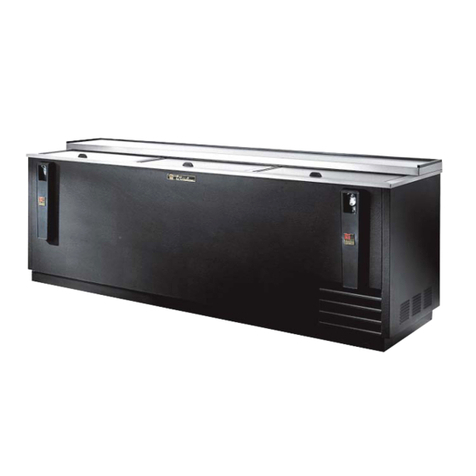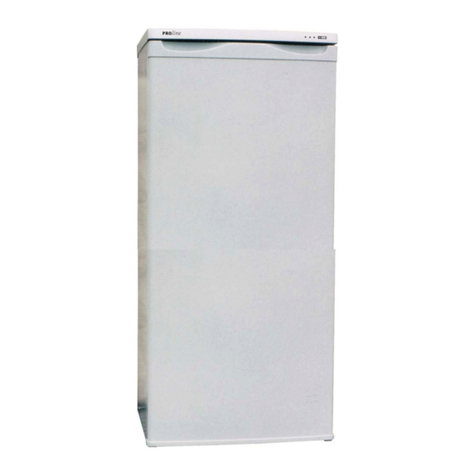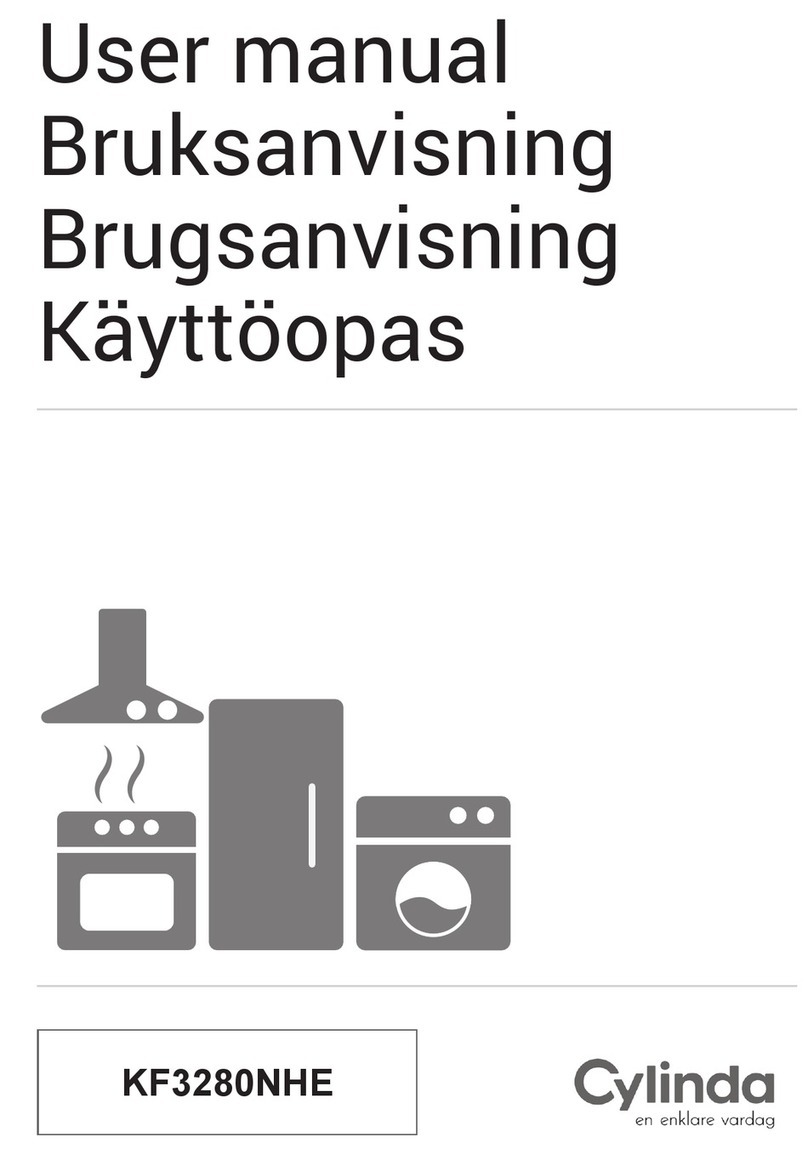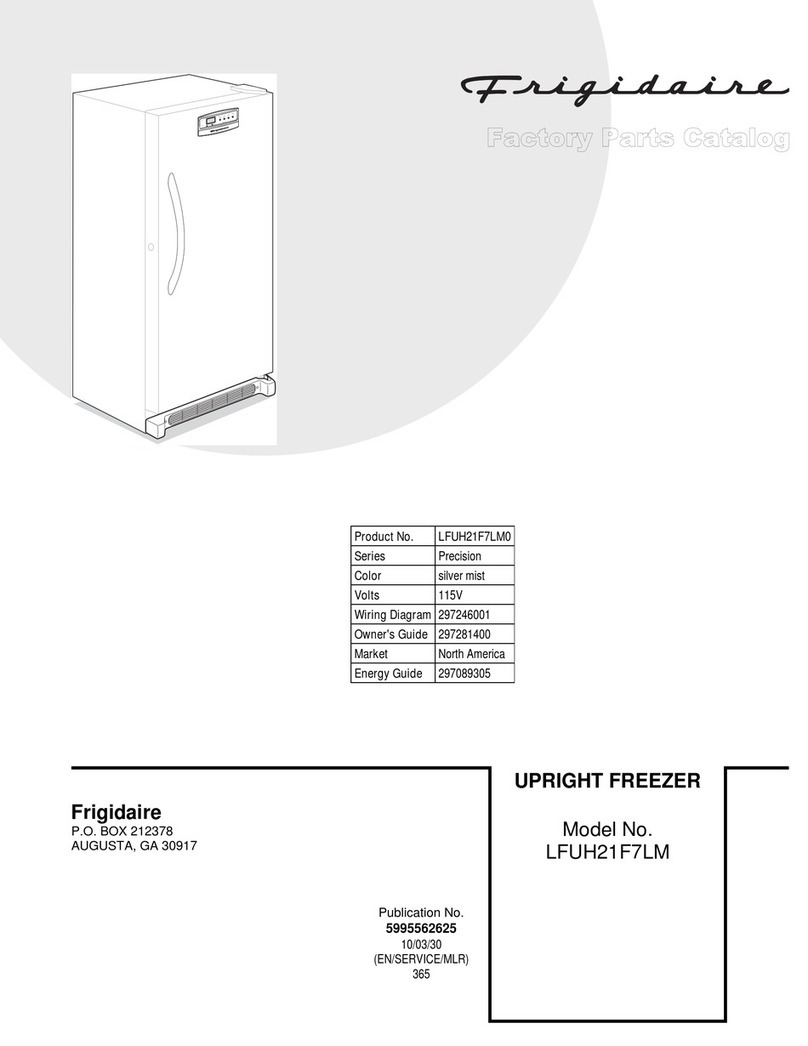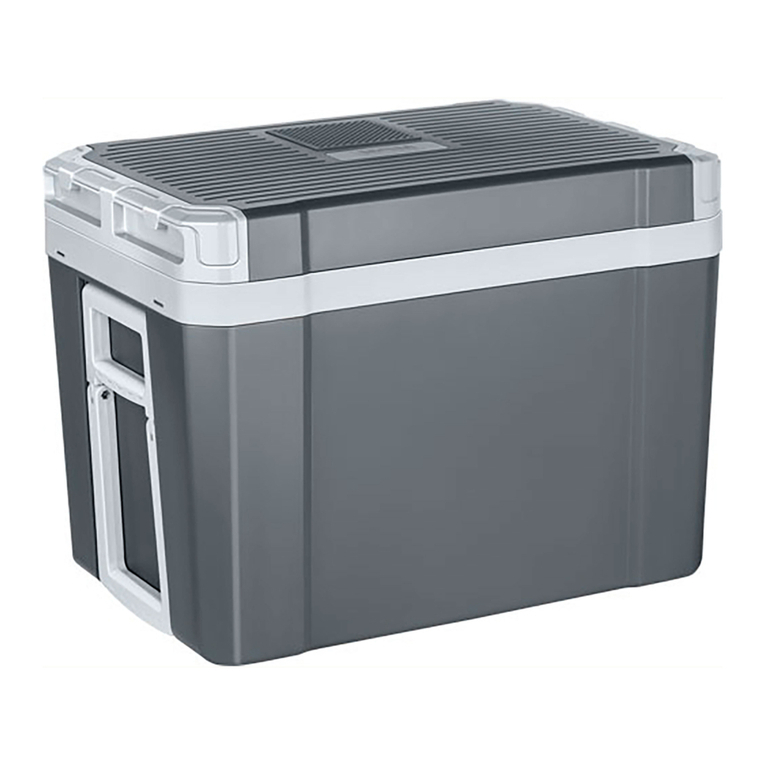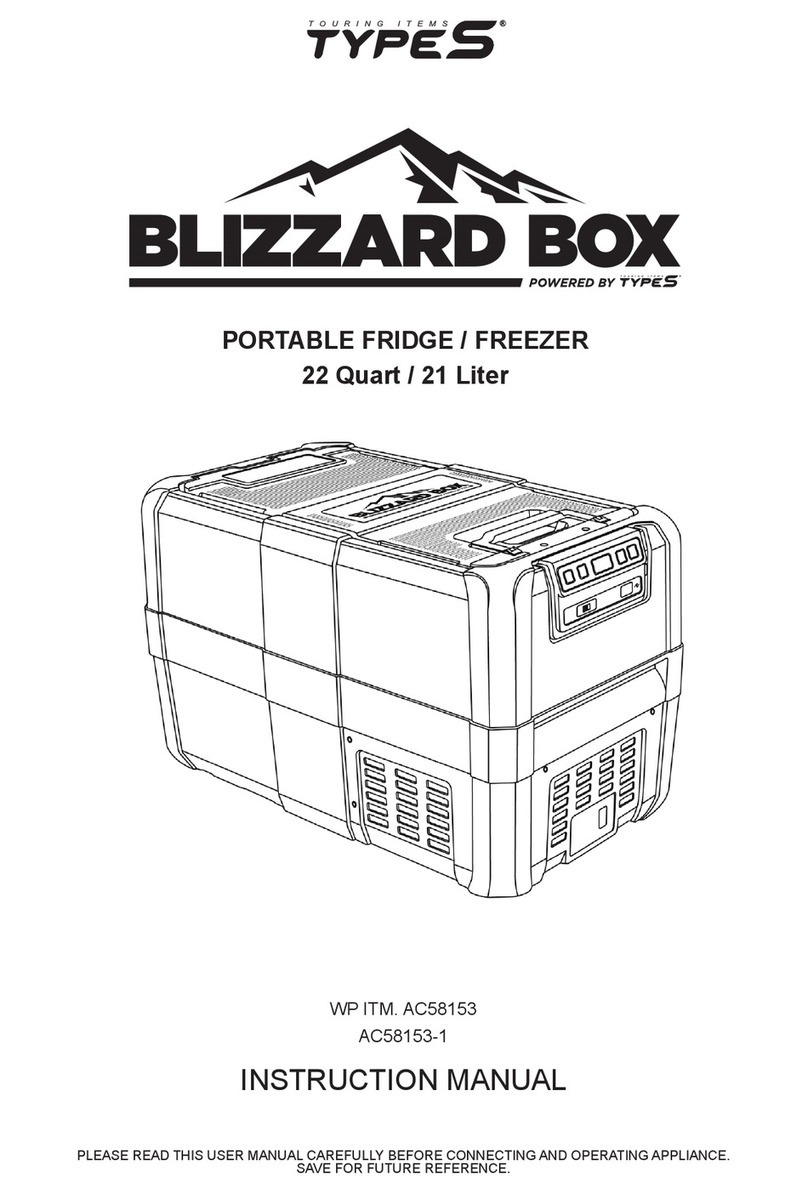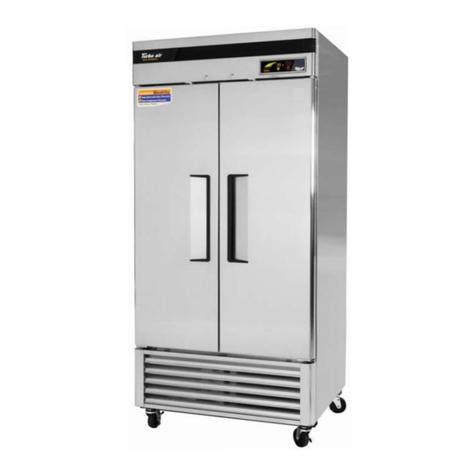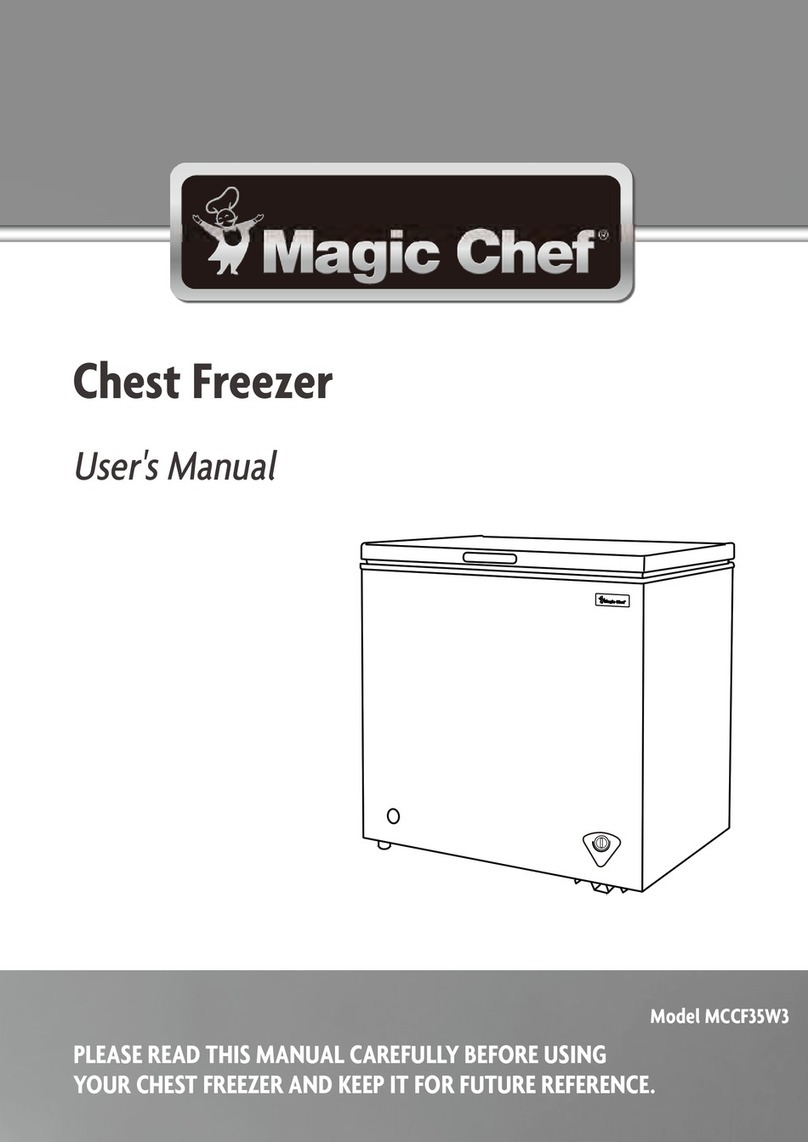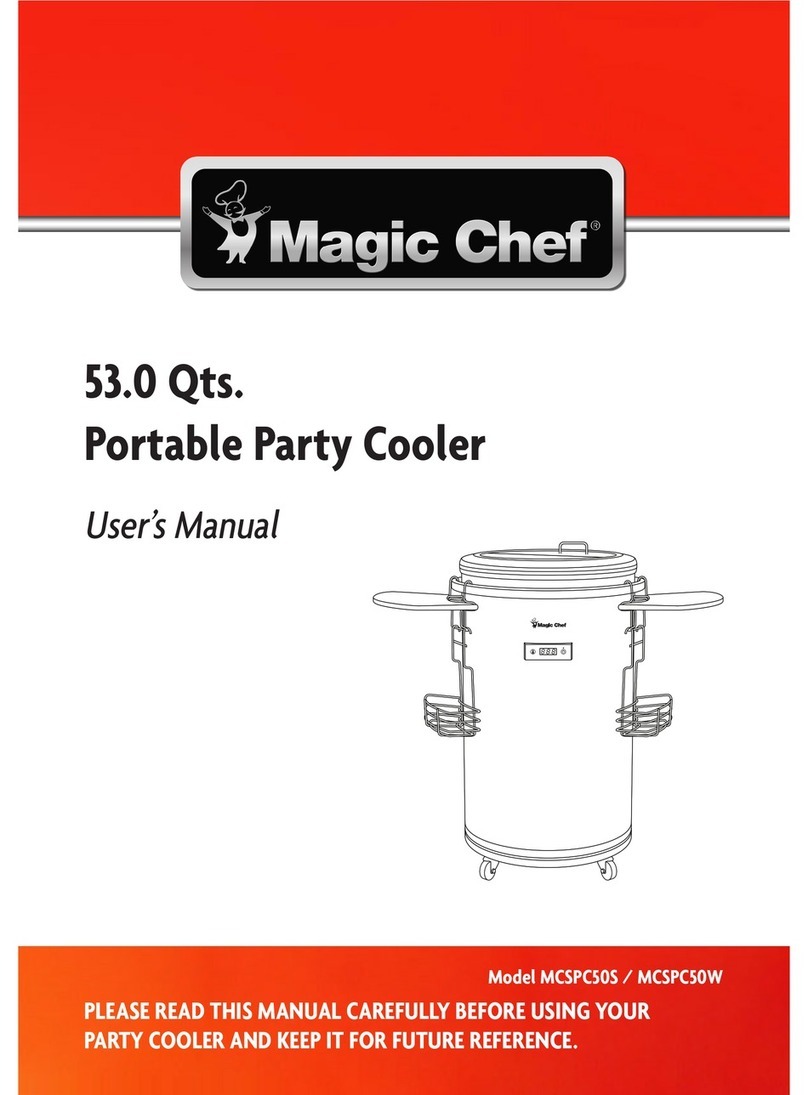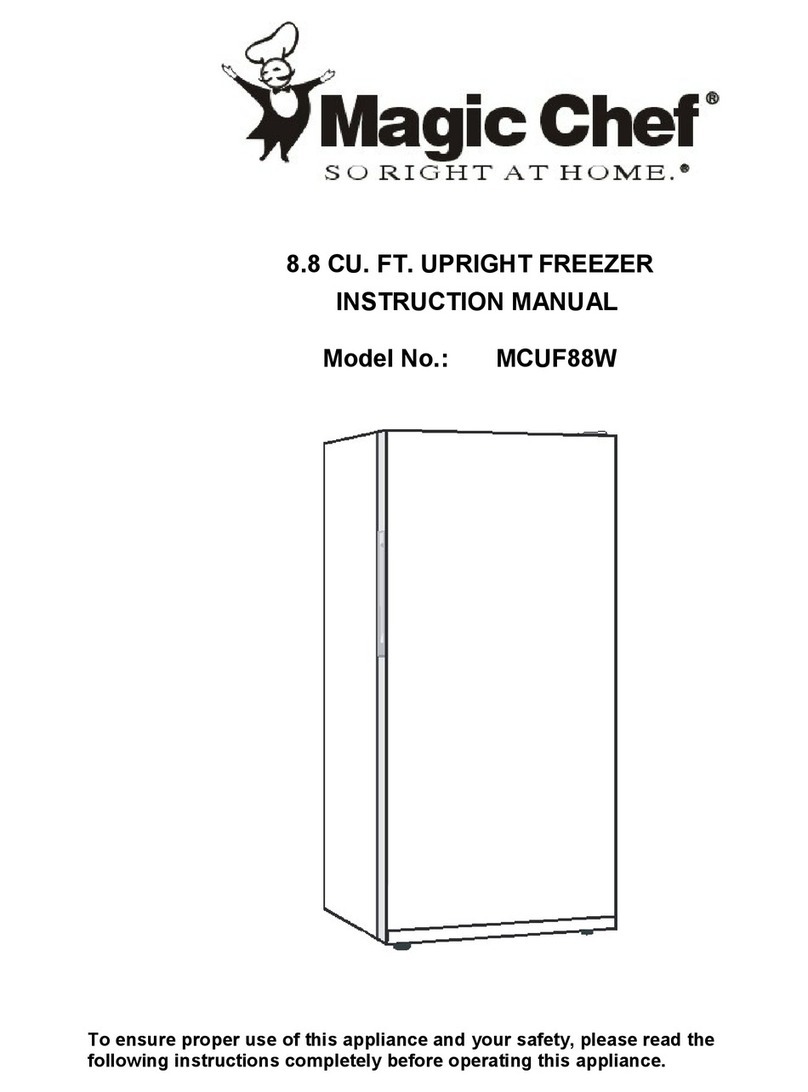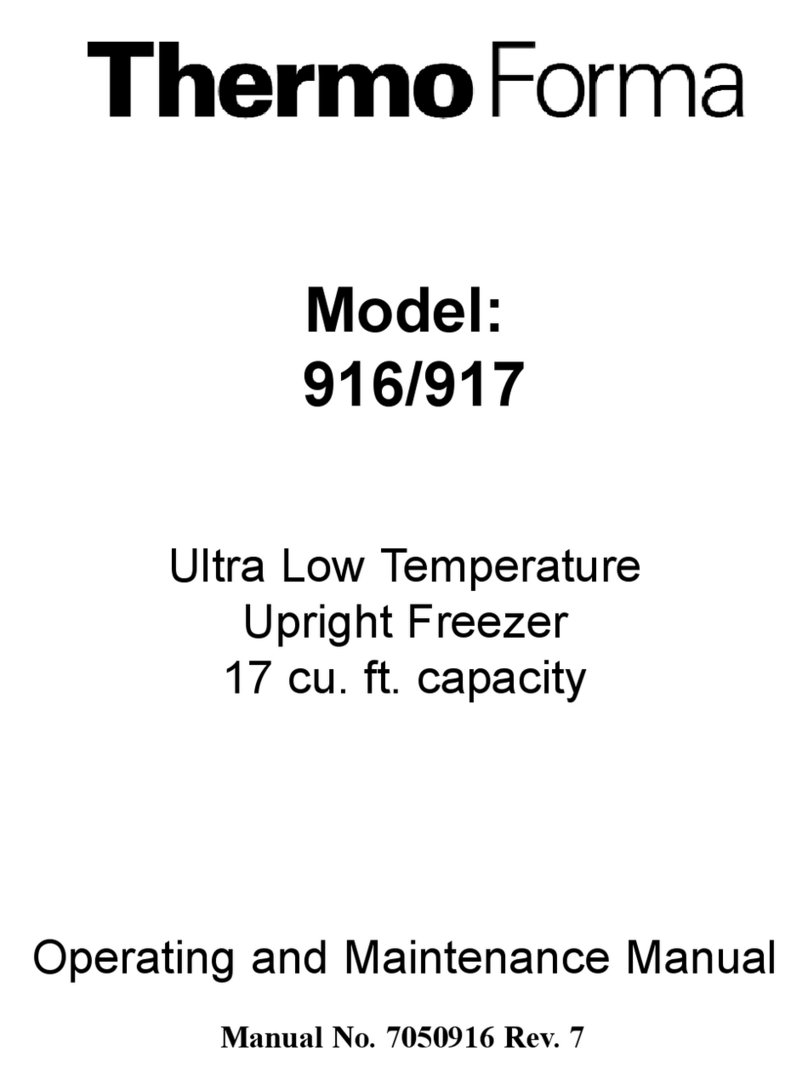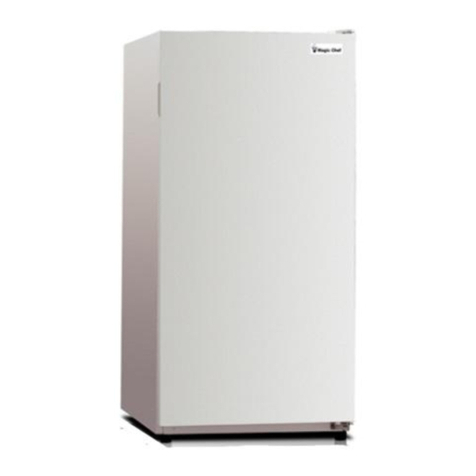Elecriq eiQCHEST400 User manual

USER MANUAL
eiQCHEST400
400 Litre Chest Freezer
Thank you for choosing electriQ
Please read this user manual before using this
Chest Freezer and keep it safe for future reference.
Visit our page www.electriQ.co.uk for our entire product range

2
CONTENTS
SAFETY WARNINGS
3
PROPER USE OF THE FREEZER
PLACEMENT
6
STARTING TO USE
6
ENERGY SAVING TIPS
7
KEY COMPONENTS
7
CONTROL DIAL
8
CARE AND MAINTENANCE
OVERALL CLEANING
9
DEFROSTING
9
WHEN NOT IN OPERATION
10
DRAIN OUTLET
10
TROUBLESHOOTING
11
SUPPORT
12
DISPOSAL
12
PRODUCT FICHE
13

3
SAFETY WARNINGS
For your continued safety and to reduce the risk of injury or electric
shock, please follow all the safety precautions listed below.
•Read all instructions carefully before using the appliance and
keep them for future reference.
•Retain the manual. If you pass the unit onto a third party, make
sure to include the manual.
•This appliance is intended to be used in household and similar
applications and is not designed for use within a commercial
environment. It shall not be used for other purposes, such as
storage of blood, drugs or biological products, etc.
•This appliance can be used by children aged from 8 years and
above and persons with reduced physical sensory or mental
capabilities or lack of experience and knowledge if they have
been given supervision or instruction concerning use of the
appliance in a safe way and understand the hazards involved.
•Children aged from 3 to 8 years are allowed to load and unload
refrigerating appliances with adult supervision.
•Cleaning and user maintenance shall not be made by children
without supervision.
•Children should be supervised to ensure that they do not play
with the appliance.
•If the doors are lockable, the keys must be kept out of the reach
of children and not in the vicinity of the appliance, in order to
prevent children from being locked inside.
•Risk of child entrapment. Before you dispose of your old fridge
or freezer:
oTake off the doors
oLeave the shelves in place so that children may not easily
climb inside.
•Do not allow any child to get into or climb into the appliance;
otherwise suffocation or injury may occur.
•The unit must be maneuvered by a minimum of 2 people.
•When positioning the appliance, ensure the supply cord is not
trapped or damaged.
•This appliance can be placed in out buildings or other cold areas.
Prolonged operation at an ambient temperature below -15⁰C will

4
affect the performance and energy consumption of the unit.
•Keep ventilation openings in the appliance enclosure or in the
built in structure, clear of obstruction.
•Use a dedicated power socket. The power socket shall not be
shared with other electrical appliances.
•Do not locate multiple portable socket-outlets or portable power
supplies at the rear of the appliance.
•Ensure the socket is suitably earthed. If in any doubt a suitable
socket must be installed by a qualified electrician.
•Do not use extension cords or ungrounded adapters.
•Do not use if the power cord is damaged. It must be replaced by
the manufacturer, its service agent or a similarly qualified person.
•Do not put flammable, explosive, volatile and highly corrosive
items in the appliance to prevent damage to the product or fire.
•Do not place flammable items near the refrigerator.
•Do not use electrical appliances inside the food storage
compartments of the appliance.
•Do not place heavy objects on the top of the refrigerator
considering that objects may fall when the door is opened or
closed.
•Do not store beer, beverages or other fluid contained in bottles or
enclosed containers in the freezer; otherwise they may crack
during freezing.
•Fizzy drinks should not be stored in the freezer.
•Do not exceed the storage time(s) recommended by the food
manufacturers for any kind of food and particularly for
commercially quick-frozen food in the freezer.
•The gaps between the refrigerator doors and between the doors
and the body are small. Do not insert fingers in these areas to
prevent injury.
•Do not handle food or containers from the freezer when your
hands are wet, as this could result in frostbite.
•If leaking gas is suspected within the room, turn off the gas and
open doors and windows. Do not unplug appliances as they may

5
spark and cause an explosion.
•Unplug the appliance during cleaning. Do not reconnect the
power to the appliance within five minutes to prevent damage to
the compressor due to successive starts.
•When unplugging the appliance firmly grasp the plug and pull out
from the socket. Do not pull the power cord.
•Do not use mechanical devices or other means to accelerate the
defrosting process.
•While defrosting the appliance, precautions should be taken to
maintain the temperature of the food, such as wrapping in towels,
or moving to another appliance.
•The rise in temperature of the frozen food during manual
defrosting, maintenance or cleaning could shorten its storage life.
•The appliance has to be unplugged after use and before carrying
out user maintenance on it.
•Do not damage the refrigerant circuit.
•Do not disassemble or reconstruct the refrigerator; maintenance
of the appliance must be conducted by a specialist.
•Diagrams within the manual are for illustrative purposes only,
due to continual product improvement the product may vary from
the illustrations.
RISK OF FIRE / FLAMMABLE MATERIALS
To avoid contamination of food, please note:
•Opening the doors for long periods can cause a significant increase of
temperature within the appliance.
•Surfaces that come into contact with food, and accessible drainage
systems should be cleaned regularly.
•Raw meat and fish should be stored in suitable containers so it cannot
come into contact with or drip onto other food.
•If the appliance is to be left empty for a prolonged period, it should be
switched off, defrosted, cleaned and dried before storage. It is also
advisable to remove the doors to prevent the growth of mould.

6
PROPER USE OF THE FREEZER
PLACEMENT
Before use, remove all packing materials from inside and outside of the
freezer. Tear off any protective film on the door or freezer body.
Keep away from heat and avoid direct sunlight. Do not place the freezer in
damp places to prevent rust or reduction of the insulating effect.
Do not spray or wash the freezer; do not put the freezer in places where it
may be splashed with water so as not to affect its electrical insulation
properties.
The freezer is to be placed in a well-ventilated indoor place. To ensure
adequate ventilation the top must not be covered and at least 70cm left above
the appliance for ventilation / opening of the lid. At least 20cm must be left to
both sides and the rear for ventilation. In addition the ground shall be flat, and
sturdy.
PRECAUTIONS BEFORE INSTALLATION OR ADJUSTMENT
•Information in the Instruction Manual is only for reference. The physical
product may differ.
•Before installation and adjusting of accessories, ensure that the freezer is
disconnected from the power.
STARTING
•Before initial use, keep the freezer still for 30 minutes before connecting it
to a power supply.
•Before putting any food into the unit, the freezer should be left to run for
2-3 hours, or for above 4 hours in summer when the ambient temperature
is high.

7
ENERGY SAVING TIPS
•The appliance should be located in the coolest area of the room, away
from heat producing appliances or heating ducts, and out of the direct
sunlight.
•Let hot foods cool to room temperature before placing in the appliance.
Overloading the appliance forces the compressor to run longer. Foods
that freeze too slowly may lose quality, or spoil.
•Be sure to wrap foods properly, and wipe containers dry before placing
them in the appliance. This cuts down on frost build-up inside the
appliance.
•Appliance storage bin should not be lined with aluminum foil, wax paper,
or paper toweling. Liners interfere with cold air circulation, making the
appliance less efficient. Organize and label food to reduce the amount of
time the unit is open and to prevent extended searches. Remove as
many items as needed at one time, and close the lid as soon as possible.
KEY COMPONENTS
Please Note: The diagram is for
reference purposes only. Due to
continual product improvement,
and variations between models
the actual product may vary.
Handle
Door
Hinge
Basket
Cabinet
Vent
Feet

8
FREEZING
•The low temperature freezing chamber may keep food fresh for a long time
and it is mainly used to store frozen foods and making ice.
•The freezing chamber is suitable for storage of meat, fish, rice balls and
other foods not to be consumed in short term.
•Meat is preferably divided into small pieces for easy access. Please note
food shall be consumed within the shelf time.
Note: Storage of too much food during operation after the initial connection to
power may adversely affect the freezing effect of the refrigerator.
Foods stored shall not block the air outlet; or otherwise the freezing effect will
also be adversely affected.
CONTROL DIAL
POWER –Turn your freezer on or off.
UP/DOWN –Change the temperature between -12⁰and -24⁰C
SUPER FREEZE –The freezer will freeze items at a much faster rate, and use more
energy. please keep the compressor continuous operating without stopping, the food
can be quickly cooled.
ALARM- If the temperature sensor’s temperature is more than -12 degrees after 3
hours of the freezer being plugged, the alarm light will be on and a buzzer will sound.
You can press any button on unlocked control panel to stop the beeping. And if the
temperature is still more than -12 degrees, the buzzer starts beeping again. The buzzer
stops beeping when the temperature is less than -12 degrees.
CHILD LOCK –When the appliance is on the freezer will automatically enter child lock
mode. To exit this mode press and hold the up and down buttons at the same time.

9
MAINTENANCE AND CARE
Please unplug the appliance before cleaning, maintenance or defrosting is
carried out. During cleaning it is advised that all removable parts are taken
from the appliance and cleaned separately to allow access to all gaps and
crevices within the appliance.
OVERALL CLEANING
•Dust behind the refrigerator and on the ground should be cleaned regularly
to improve the cooling effect and reduce energy usage.
•The interior of the refrigerator should be cleaned regularly to avoid odours.
•Soft towels or a sponge dipped in water and non-corrosive neutral
detergents are suggested for cleaning.
•The appliance should be cleaned with clean water and a cloth.
•Following cleaning the surfaces should be wiped dry.
•Door seals should be regularly checked for damage and cleanliness and
cleaned with mild soap and water.
•Open the door to allow natural drying before the power is turned back on.
•Do not use hard brushes, steel balls, wire brushes, abrasives, such as
toothpastes, organic solvents (such as alcohol, acetone, banana oil, etc.),
boiling water, acid or alkaline items to clean the appliance as this could
damage its surface and interior.
•For areas that are difficult to clean within the appliance, such as narrow
gaps and corners, it is recommended to wipe them regularly with a soft
cloth or brush.
•Do not rinse with water so as not to affect the electrical insulation
properties.
DEFROSTING
Frost formed due to change of season or temperature may also be manually
removed by disconnecting the appliance from the power supply or by wiping
with a dry towel.

10
WHEN NOT IN OPERATION
POWER FAILURE
In case of power failure, even if it is in summer, food inside the appliance can
be kept for several hours; during the power failure keep the doors of the
appliance closed, and do not insert more food.
LONG-TIME STORAGE
The appliance should be unplugged and then cleaned. The doors should be
left open or removed to prevent the build-up of odours.
TRANSPORTATION
Before the appliance is moved, remove all objects from inside, fix the glass
partitions, vegetable holder, freezing chamber drawers and etc. with tape, and
tighten the leveling feet; close the doors and seal them with tape. During
moving, the appliance must not be laid upside down or horizontally, or be
vibrated; the inclination during movement shall be no more than 45°. Once
moved it should be left to settle before plugging in, as per the advice for first
use.
The appliance runs continuously once it is started. Generally, the operation of
the appliance should not be interrupted; or otherwise the service life may be
impaired.
DRAIN OUTLET
Use to drain excess water after defrosting.

11
TROUBLESHOOTING
You may try to solve the following simple problems by yourself.
If they cannot be solved, please contact the after-sales department.
Not operating
Check whether the appliance is connected to power or whether the
plug is in well inserted.
Check whether there is a power failure or partial circuits have tripped
Odours
Odorous foods should be tightly wrapped
Check whether any food is spoilt.
Clean the inside of the appliance
Long-time
operation of
the
compressor
Long operation of the refrigerator is normal in summer when the
ambient temperature is high
Do not overload the appliance. Airflow is required for efficient cooling.
Food shall be cool before being placed into the appliance
The lid is opened too frequently
Doors cannot
be properly
closed
The lid is stuck by food residue
The appliance is not level.
Loud noise
Check whether the floor is level and whether the freezer is placed
stably
Check whether accessories are placed in their proper locations
Lid fails to be
tight
Remove foreign matters on the lid seal
Heat the lid seal and then cool it for restoration
(or blow it with a hair drier or use a hot towel for heating)
Hot housing
Heat dissipation of the built-in condenser via the housing, which is
normal. When housing becomes hot due to high ambient temperature
and storage of too much food, it is recommended to provide adequate
ventilation to facilitate heat dissipation.
Surface
condensation
Condensation on the exterior surface and seals of the freezer is
normal when the ambient humidity is very high. Just wipe the
condensate with a clean towel.
Abnormal
noise
Buzz: The compressor may produce buzzes during operation, and the
buzzes are loud particularly upon starting or stopping. This is normal.
Creak: Refrigerant flowing inside of the appliance may produce a
creaking noise, which is normal.

12
electriQ UK SUPPORT
www.electriQ.co.uk/support
Call: 0333 043 6692 or complete the online form
Office hours: 9AM - 5PM Monday to Friday
www.electriQ.co.uk
Unit J6, Lowfields Business Park
Lowfields Way, Elland
West Yorkshire, HX5 9DA
DISPOSAL
Refrigerant and cyclopentane foaming materials used within the
appliance are flammable. Therefore it must be kept away from
fire to prevent damage to the environment or injury.
Do not dispose this product as unsorted waste. Collection
of such waste must be handled separately as special
treatment is necessary.
Recycling facilities are now available for all customers at which you can
deposit your old electrical products. Customers will be able to take any old
electrical equipment to participating sites run by their local councils. Please
remember that this equipment will be further handled during the recycling
process, so please be considerate when depositing your equipment. Please
contact the local council for details of your local household waste recycling
centres.

13
PRODUCT FICHE
MODEL
400L
Total Gross Volume(L)
400L
Gross Freezer Volume(L)
400L
Freezer Storage Volume(L)
400L
Refrigerant, Amount
R600a/100g
Freezing Capacity(kg/24h)
18kg/24h
Temperature Rise Value
38h
Net Weight(kg)
54kg
Gross Weight(kg)
62kg
Noise(dB(A))
41dB(A)
Product Dimensions(mm) (WXDXH)
1365x730x835
Energy efficiency class
F
Energy consumption e16
0.568 (kwh/24h)
Energy consumption e32
1.054 (kwh/24h)
Rated current(a)
0.94A
Rated voltage/frequency
220V-240V/50Hz
Climate class
N/SN/ST/T
Compressor
PZ99H1X
V20202224
This manual suits for next models
1
Table of contents


